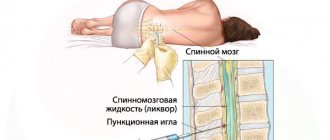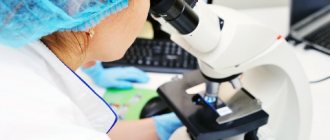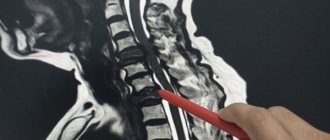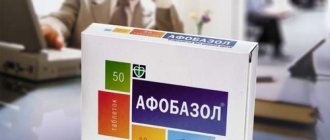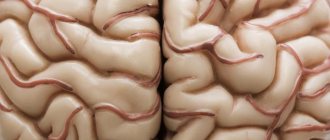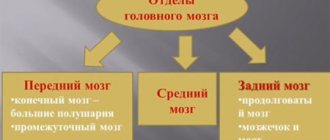Lumbar puncture is the procedure of inserting a needle into the subarachnoid space of the spinal cord at the lumbar level. It is performed to determine spinal pressure, obtain cerebrospinal fluid to study the composition of the cerebrospinal fluid and for anesthesia. Lumbar puncture in Moscow is performed at the Yusupov Hospital. Neurologists perform spinal taps for both diagnostic and therapeutic purposes. The neurology clinic has all the conditions for treating patients:
- rooms of varying comfort levels are equipped with air conditioning;
- patients are provided with individual personal hygiene products and dietary nutrition;
- Doctors use modern diagnostic equipment from leading companies in the world to examine patients;
- medical staff is attentive to the wishes of patients and their relatives.
The Yusupov Hospital employs candidates and doctors of medical sciences, doctors of the highest category. They are fluent in the technique of performing lumbar puncture. Lumbar puncture is performed for stroke and traumatic brain injury. Lumbar puncture for multiple sclerosis is necessary to obtain cerebrospinal fluid for laboratory testing. The detection of a large number of immunoglobulins (antibodies) in the cerebrospinal fluid, as well as oligoclonal bands (a special arrangement of immunoglobulins during a more specific test) or the determination of proteins - products of myelin breakdown, gives doctors reason to assume a diagnosis of multiple sclerosis. The lumbar puncture protocol is recorded in the medical history.
2.Why are bone marrow biopsies and spinal taps performed?
A bone marrow biopsy and puncture is performed to:
- Find the cause of changes in red blood cells, white blood cells, or platelets in patients with thrombocytopenia, anemia, or abnormal white blood cell counts.
- Identify blood disorders such as leukemia, anemia, or factors affecting the bone marrow (multiple myeloma or polycythemia).
- Make sure that Hodgkin lymphoma or another type of lymphoma has not spread to the bone marrow.
- Look for infections or tumors that may have spread to the bone marrow.
- Find the best treatment methods for bone marrow diseases.
- Collect bone marrow samples for medical procedures such as stem cell transplants or chromosomal analysis.
Oncology clinic in Moscow
Oncology clinic in Moscow ¦ CANCER DIAGNOSIS IN A EUROPEAN CLINIC ¦ Lumbar puncture
Collection of a spinal tap
A lumbar puncture is a diagnostic procedure in which cerebrospinal fluid is collected.
Puncture is part of many methods for diagnosing spinal diseases. A lumbar puncture can diagnose a wide range of diseases.
During a lumbar puncture, a needle is inserted into the subarachnoid space for diagnostic or therapeutic purposes. The procedure, carried out for diagnostic purposes, allows one to examine the cerebrospinal fluid.
The study evaluates the color of the liquor, its transparency, and cellular composition. After this, the biochemical composition of the cerebrospinal fluid is studied, microbiological tests are carried out, including culture on various media.
During a lumbar puncture, cerebrospinal fluid pressure is measured and the patency of the subarachnoid space is assessed. For this purpose, compression tests are carried out.
Indications for lumbar puncture
Indications for lumbar puncture:
- encephalitis,
- meningitis,
- ventriculitis,
- malignant neoplasm in the membranes of the spinal cord or brain,
- normal pressure hydrocephalus,
- detection of cerebrospinal fluid fistulas,
- diagnosis of subarachnoid hemorrhages (if computed tomography is not possible).
Relative indications are: fever of unknown origin in children under 2 years of age, demyelinating process, septic vascular embolism, inflammatory polyneuropathy, systemic lupus erythematosus, paraneoplastic syndrome.
Spinal puncture technique
The technique for performing a lumbar puncture is quite simple. As a rule, it is combined with x-ray examination. In this case, the patient requires preliminary special preparation.
Before lumbar puncture, it is necessary to cleanse the intestines.
Puncture technique: the patient lies on his side and draws his legs to his chest. The doctor treats the skin on the patient’s back with an antiseptic.
Sterile disposable needles are used for the procedure. They are printed immediately before the procedure. The doctor then performs a puncture between the third and fourth vertebrae.
First, a thin needle is inserted through which an anesthetic drug is delivered. After this, the thin needle is removed and a thicker one is inserted - a puncture needle. Then the cerebrospinal fluid is collected.
A lumbar puncture usually does not take long. Many patients are interested in whether a lumbar puncture is painful?
During the puncture, discomfort is possible; in the European clinic the procedure is performed under local anesthesia.
| European Oncology Clinic Request for consultation and treatment +7(925)191-50-55 Moscow, Dukhovskoy lane, 22b |
| Methods for diagnosing cancer |
| Biopsy - types of biopsy |
| Biopsy – Conchotome biopsy |
| Biopsy - Open biopsy of superficial lesions |
| Biopsy - Incisional soft tissue biopsy |
| Biopsy – Incisional breast biopsy |
| Biopsy - Lymph node puncture |
| Biopsy - Excisional lymph node biopsy |
| Biopsy – Excisional biopsy of the inguinal lymph node |
| Biopsy – Excisional biopsy of the cervical lymph node |
| Biopsy - Puncture aspiration biopsy of internal organs |
| Biopsy—Puncture aspiration biopsy of soft tissue |
| Biopsy - Taking material during endoscopy |
| Posterior fornix puncture |
| Lumbar puncture |
| Angiography |
| Cavagraphy |
+7(925)191-50-55 — European treatment protocols in Moscow
REQUEST TO THE CLINIC
3.How is a biopsy performed?
These procedures are performed by a hematologist, oncologist, internist, pathologist, or specially trained physician. In adults, a sample of bone marrow fluid is usually taken from the back of the pelvic bone. In rare cases, a fluid sample is taken from the chest or the front of the pelvic bone. In young children, samples are obtained from the front lower part of the lower leg, just below the knee. A bone marrow biopsy is taken only from the pelvic bone. The puncture is performed using a needle. A biopsy uses a special instrument that is screwed into the bone.
What is a puncture
As a medical procedure, puncture involves making a puncture in the part of the body desired by the doctor using a special puncture needle. The object of the puncture can be an organ and cavity, vein or bone - this method is used for a variety of purposes.
One of these goals is to conduct a complete and comprehensive diagnostic that is informative based on the results. In this case, the doctor realizes the opportunity to extract from the body a sufficient amount of biomaterial for laboratory research and subsequent study of which will allow diagnosing the pathology. Often, through punctures, coloring components are introduced into the area itself, and this will allow for X-ray diagnostics.
Puncture is performed as a therapeutic rather than diagnostic method. As an example, it is used to inject medicinal compounds into the lesion. Also, in addition to this, with the help of a puncture, you can pump out a pathological accumulation of fluid or remove air, and carry out therapeutic rinsing.
4. Bone marrow biopsy results
Bone marrow biopsy results are usually ready within a week.
The following indicators are considered the norm:
- Bone marrow has normal amounts of fat, connective tissue, and iron. Normal ratio of adult and growing bone marrow cells.
- There are no signs of infection.
- There are no cancer cells such as leukemia, lymphoma or multiple myeloma.
- There is no spread of cancer cells from other affected areas.
Deviation from the norm:
- Bone marrow cells with pathology.
- The ratio of the number of different cells is disturbed.
- Bone tissue with pathology.
- Too much iron or too little iron (iron deficiency anemia).
- There are signs of infection.
- Cancer cells (leukemia, lymphoma, or multiple myeloma) are present.
- The bone marrow is replaced by scar tissue.
Depending on the results of a bone marrow biopsy or spinal tap, the doctor may prescribe additional examinations, select or adjust a treatment regimen, or, conversely, make sure that everything is in order with your health.
Therapeutic lumbar puncture
The procedure is used not only as a diagnosis, but also during therapeutic measures:
- Injecting medications directly into the spinal cord, such as some chemotherapy drugs;
- Surgical pain relief - in this case, lumbar puncture is used as lumbar anesthesia, for example, for caesarean section or hip surgery;
- Therapy for prolonged headaches, for example, with the so-called spontaneous syndrome of liquor hypotension, accompanied by severe headaches (during a liquor puncture, the doctor injects his own blood into the epidural area).
Brain tumor symptoms
Signs of the disease can vary, depending on the size of the tumor, its location and the pressure on surrounding tissue. When located in a certain part of the brain, certain functions are disrupted. Among the main symptoms of cancer:
- complete or partial loss of sensation in the limbs;
- nausea and vomiting;
- blurred vision (a veil may appear before the eyes);
- general weakness, fatigue;
- double vision;
- frequent headaches of varying intensity and character, sometimes it can intensify with changes in body position or sudden movements;
- disturbance of normal speech;
- problems with spatial orientation and balance.
In later stages, cancer may present with personality changes and confusion.
Possible complications
Thyroid puncture is rarely accompanied by complications. Ultrasound-assisted navigation makes this procedure even safer. Cases of spread of a malignant tumor due to needle insertion, damage to neighboring organs, nerves, and blood vessels are practically never encountered.
Most often, after a fine-needle biopsy, pain occurs and the color of the skin at the injection site changes slightly. But even small hemorrhages on the skin are rare. Isolated cases have been described in which bleeding developed into the cyst, and because of this it had to be removed.
If the rules of asepsis and antisepsis are followed, the risk of infection is also extremely unlikely.
We will call you back
Message sent!
expect a call, we will contact you shortly
When is the puncture performed?
In the stimulated cycle, the puncture is carried out approximately on the 12-14th day, but the main guideline is the size of the growing follicles. Eggs are obtained 35-36 hours after the administration of an ovulation trigger (human chorionic gonadotropin or GnRH agonist) - a drug that stimulates the final maturation of oocytes.
The date is determined by the attending physician, based on the results of folliculometry. It is very important to carry out the puncture within a clearly defined time interval. If this happens prematurely, there is a high risk of receiving immature germ cells. If you are late, spontaneous ovulation (the release of oocytes from the ovary into the abdominal cavity) will occur 38-42 hours after the administration of hCG.
In some cases, an ultrasound is performed before the puncture to determine the number and location of follicles in the ovary.
History of the method
In vitro fertilization has been successfully used to treat infertility for several decades. Over the years, the method of obtaining eggs has also changed significantly.
At first it was quite difficult to do this. Doctors had to perform a full-fledged operation, as a result of which it was not always possible to obtain eggs. In particular, the success of the manipulation was influenced by such factors as the presence of adhesions in the pelvis, pathologies of the fallopian tubes and the localization of the ovaries.
In 1982, specialists developed a new technique that involved inserting a needle through the abdominal wall and bladder. The manipulation was carried out under ultrasound control. Although access to the ovary has become easier and the risk of potential complications has decreased, the effectiveness of the puncture remains low.
The situation changed with the advent of the transvaginal sensor, thanks to which it became much easier to obtain follicular fluid containing eggs, and the likelihood of complications was significantly reduced.
Preparation for the procedure
Thyroid puncture does not require special preparation. There is no need to adjust your lifestyle, adhere to a special diet, etc. If the patient is constantly taking any medications, then they do not need to be discontinued, with the exception of anticoagulants. These drugs are used to “thin the blood” and prevent blood clots. Because of them, after a puncture of the thyroid gland, the risk of bleeding may increase. The doctor decides whether they should be canceled a few days before the procedure.
Typically, fine-needle aspiration biopsy is performed by endocrinologists. They are better at this than other specialists because they often have to palpate the thyroid gland. It is advisable that the puncture be carried out by a doctor who will subsequently care for the patient.
Contraindications for puncture
Despite numerous indications, puncture of the chest wall is not recommended in some cases. However, most of the contraindications are relative. For example, regardless of the high risks for the patient in the case of valvular pneumothorax, pleural puncture is performed to save his life.
The following are the circumstances in which physicians will have to decide whether to perform a thoracentesis on an individual basis:
- High risks of serious complications during and after puncture.
- Instability in the patient's condition (myocardial infarction, angina, acute heart failure or hypoxia, arrhythmia).
- Pathology of blood clotting.
- Continuous cough.
- Bullous emphysema.
- Features in the anatomy of the chest.
- The presence of fused layers of the pleura with obliteration of the pleural cavity.
- High degree of obesity.
Cost of lumbar puncture in Germany
Cerebrospinal fluid puncture is prescribed in accordance with the clinical recommendations of your doctor at the Nordwest Clinic. The cost depends on the purpose of the procedure: diagnostic or therapeutic. You can find out the prices for a lumbar (spinal) puncture by calling the clinic at 8 800 551 8099. You can discuss the feasibility of this procedure remotely, without traveling abroad. To do this, you can use services such as a video consultation with a doctor at the Nordwest clinic or a “Second opinion from a specialist from Germany.”
